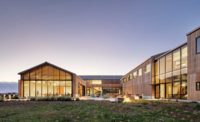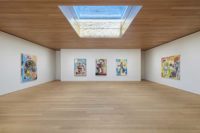Phoenix, Arizona
Owner: Maricopa Community College District
Completion Date: January 2010
Program: A two-story, 35,000-square-foot center for Paradise Valley Community College's life sciences programs. The first floor of the L-shaped steel structure houses laboratories, and the second floor contains classrooms and faculty offices. Located toward the southern side of the college's 1970s campus, the building links the north and south ends of the grounds with a pedestrian bridge running along its east facade.
Design concept and solution: Though Paradise Valley Community College is an inward-looking campus, it has so far lacked a public gathering space. The architects conceived the building's east facade as a contemporary variation on a portico: structural steel columns support a wide roof canopy that accommodates a series of indoor/outdoor "pods" made of perforated steel. The seven pods—four on the first floor, three on the second—appear to float against the building's masonry and copper facade like a series of boxy, industrial porches. The pods, which are equipped with power and blackboards and are cooled by large overhead fans, serve as collaborative spaces for students and overlook a swath of desert slated to become a campus green. The pedestrian bridge runs underneath the canopy, between the building and the pods, reinforcing the idea of the project as a kind of public porch. The architects outfitted the interiors with straightforward, what-you-see-is-what-you-get materials, many of them brought in from the exterior: there are masonry corridors, sealed concrete-slab floors, and lightweight copper wall panels.
Total construction cost: $12.7 million
Location: Phoenix, Arizona
People
Owner:
Architect:
Personnel in architect's firm who should receive special credit: Team: John Hammen, AIA Project Architect, Helen Pierce, RA Lab Planner: Design for Science
Engineer(s): Structural Engineer: Paragon Structural Design Mechanical, Plumbing, Electrical Engineer: Energy Systems Design
Consultant(s) Other: Audio Visual: Convergent Technologies General contractor: Barton Malow Company (construction manager at risk)
Photographer(s) CAD system, project management, or other software used: Autodesk REVIT |
Products
Exterior cladding Custom Steel Fabrications: Triad Steel Custom aluminum curtainwall/storefront: Arcadia Concrete Stairs: Mesa Precast & Supply Concrete Cast in Place: Baker Concrete Custom copper panels: Kovach Construction Soffits: Armstrong MetalWorks
Roofing Metal roofing: Berridge Manufacturing Co.
Glazing
Doors
Hardware Exit devices: C.R. Laurence Architectural Products
Interior finishes Suspension grid: Armstrong Laboratory Casework: Advanced Lab Concepts Paints and stains: Benjamin Moore Resilient flooring: Noraplan Carpet: Flor
Lighting
Conveyance
Plumbing
Add any additional building components or special equipment that made a significant contribution to this project: |












Post a comment to this article
Report Abusive Comment